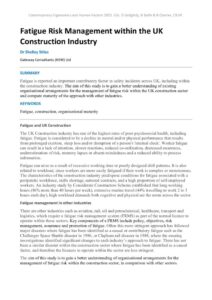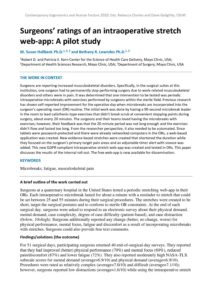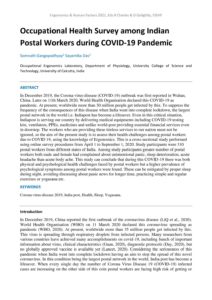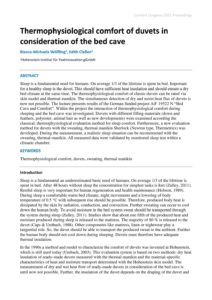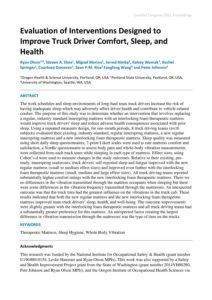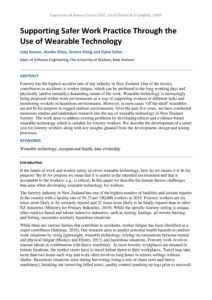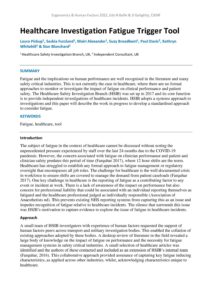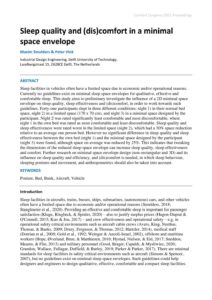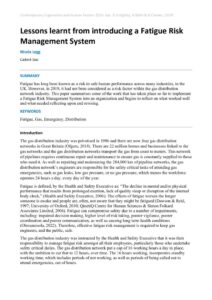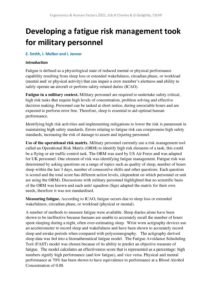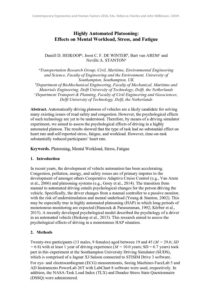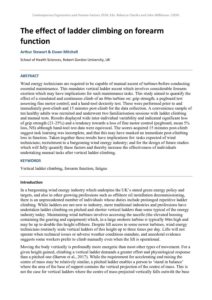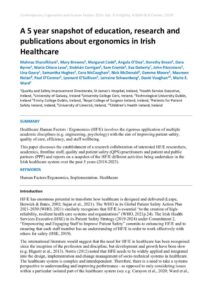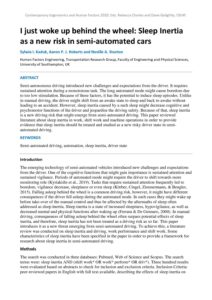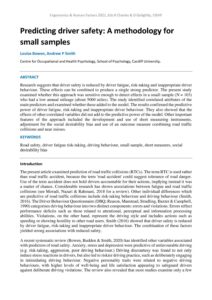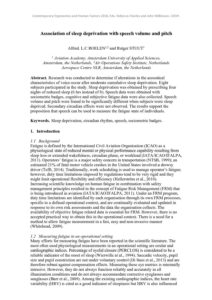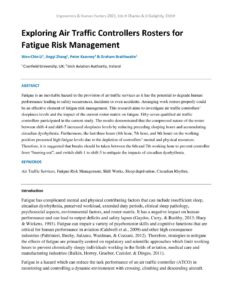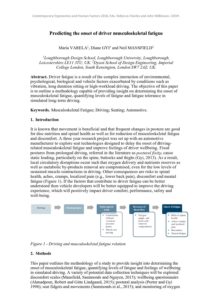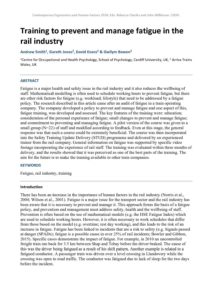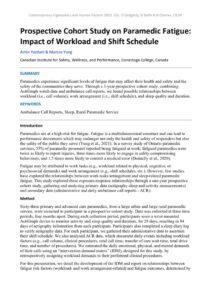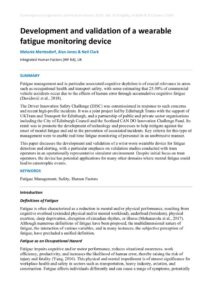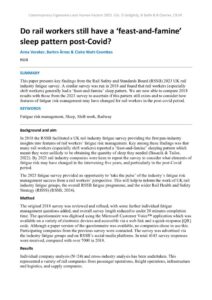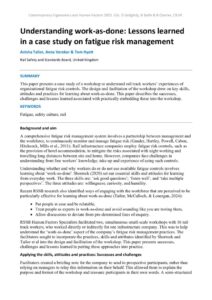Fatigue & sleep
Fatigue Risk Management within the UK Construction Industry
| Document | Author Dr Shelley Stiles |
| Abstract Fatigue is reported an important contributory factor in safety incidents across UK, including within the construction industry. The aim of this study is to gain a better understanding of existing organisational arrangements for the management of fatigue risk within the UK construction sector and compare maturity of the approach with other industries. |
Surgeons’ ratings of an intraoperative stretch web-app: A pilot study
| Document | Author M. Susan Hallbeck Ph.D and Bethany R. Lowndes Ph.D |
| Abstract Surgeons are reporting increased musculoskeletal disorders. Specifically, in the surgical suites at this institution, one surgeon had to permanently stop performing surgery due to work-related musculoskeletal disorders and others were in pain. It was determined that one intervention to be tested was periodic intraoperative microbreaks with exercises performed by surgeons within the sterile field. Previous research has shown self-reported improvement for the operative day when microbreaks are incorporated into the surgeon’s operating room (OR) routine. The initial work was done by having a 90-second microbreak leader in the room to lead calisthenic-type exercises that didn’t break scrub at convenient stopping points during surgery, about every 20 minutes. The surgeons and their teams loved having the microbreaks with exercises; however, their feedback was that the 20-minute period was not long enough and the exercises didn’t flow and lasted too long. From the researcher perspective, it also needed to be automated. Since tablets were password-protected and there were already networked computers in the ORs, a web-based application was created. New evidence-based stretches were created that shortened the duration while they focused on the surgeon’s primary target pain areas and an adjustable timer alert with snooze was added. This new GDPR compliant intraoperative stretch web-app was created and tested in ORs. This paper discusses the results of the internal roll-out. The free web-app is now available for dissemination. |
Occupational Health Survey among Indian Postal Workers during COVID-19 Pandemic
| Document | Author Somnath Gangopadhyay and Sayantika Das |
| Abstract In December 2019, the Corona-virus-disease (COVID-19) outbreak was first reported in Wuhan, China. Later on 11th March 2020, World Health Organisation declared this COVID-19 as pandemic. At present, worldwide more than 30 million people get infected by this. To suppress the frequency of the consequences of this disease when India went into complete lockdown, the largest postal network in the world i.e. Indiapost has become a lifesaver. Even in this critical situation, Indiapost is serving our country by delivering medical equipments including COVID-19 testing kits, ventilators, PPEs, medicines and unlike world-post providing essential financial services even in doorstep. The workers who are providing these tireless services to our nation must not be ignored, so the aim of the present study is to assess their health challenges among postal workers due to COVID 19, using the knowledge of Ergonomics. This is a cross-sectional study performed using online survey procedures from April 1 to September 1, 2020. Study participants were 310 postal workers from different states of India. Among study participants greater number of postal workers both male and female had complained about unintentional panic, sleep deterioration, acute headache than acute body ache. This study can conclude that during this COVID-19 there was both physical and psychological health challenges faced by postal workers but a higher prevalence of psychological symptoms among postal workers were found. These can be mitigated by proper sleep during night, avoiding discussing about panic news for longer time, practicing simple and regular exercises or yogasana etc. |
Thermophysiological comfort of duvets in consideration of the bed cave
Evaluation of Interventions Designed to Improve Truck Driver Comfort, Sleep, and Health
Supporting Safer Work Practice Through the Use of Wearable Technology
| Document | Author Judy Bowen, Annika Hinze, Jemma König and Dylan Exton |
| Abstract Forestry has the highest accident rate of any industry in New Zealand. One of the known contributors to accidents is worker fatigue, which can be attributed to the long working days and physically (and/or mentally) demanding nature of the work. Wearable technology is increasingly being proposed within work environments as a way of supporting workers in different tasks and monitoring workers in hazardous environments. However, in most cases ‘off the shelf’ wearables are not fit for purpose in rugged outdoor environments. Over the past five years, we have conducted numerous studies and undertaken research into the use of wearable technology in New Zealand forestry. The work aims to address existing problems by developing ethical and evidence-based wearable technology which is suitable for forestry workers. We describe the development of a smart vest for forestry workers along with key insights gleaned from the development, design and testing processes. |
Healthcare Investigation Fatigue Trigger Tool
| Document | Author Laura Pickup, Saskia Fursland, Mairi Alexander, Suzy Broadbent, Paul Davis, Kathryn Whitehill & Sian Blanchard |
| Abstract Fatigue and the implications on human performance are well recognised in the literature and many safety critical industries. This is not currently the case in healthcare, where there are no formal approaches to monitor or investigate the impact of fatigue on clinical performance and patient safety. The Healthcare Safety Investigation Branch (HSIB) was set up in 2017 and its core function is to provide independent investigations of healthcare incidents. HSIB adopts a systems approach to investigations and this paper will describe the work in progress to develop a standardised approach to consider fatigue. |
Sleep quality and (dis)comfort in a minimal space envelope
Lessons learnt from introducing a Fatigue Risk Management System
| Document | Author Nicola Legg |
| Abstract Fatigue has long been known as a risk to safe human performance across many industries, in the UK. However, in 2019, it had not been considered as a risk factor within the gas distribution network industry. This paper summarises some of the work that has taken place so far to implement a Fatigue Risk Management System into an organisation and begins to reflect on what worked well and what needed reflecting upon and revising. |
Developing a fatigue risk management tool for military personnel
| Document | Author E. Smith, I. Mollan and I. Jenner |
| Abstract |
Highly Automated Platooning: Effects on Mental Workload, Stress, and Fatigue
| Document | Author Daniël D. HEIKOOP, Joost C. F. DE WINTER, Bart van AREM and Neville A. STANTON |
| Abstract Automatically driving platoons of vehicles are a likely candidate for solving many existing issues of road safety and congestion. However, the psychological effects of such technology are yet to be understood. Therefore, by means of a driving simulator experiment, we aimed to assess the psychological effects of driving in a highly automated platoon. The results showed that the type of task had no substantial effect on heart rate and self-reported stress, fatigue, and workload. However, time-on-task substantially reduced participants’ heart rate. |
The effect of ladder climbing on forearm function
| Document | Author Arthur Stewart & Dawn Mitchell |
| Abstract Wind energy technicians are required to be capable of manual ascent of turbines before conducting essential maintenance. This mandates vertical ladder ascent which involves considerable forearm exertion which may have implications for such maintenance tasks. This study aimed to quantify the effect of a simulated and continuous climb of an 80m turbine on: grip strength; a pegboard test assessing fine motor control; and a hand-tool dexterity test. These were performed prior to and immediately post-climb and 15 minutes post-climb for the data collection. A convenience sample of ten healthy adults was recruited and underwent two familiarisation sessions with ladder climbing and manual tests. Results displayed wide inter-individual variability and indicated significant loss of grip strength (21-25%) and a tendency towards a loss of fine motor control (pegboard, mean 5% loss, NS) although hand-tool test data were equivocal. The scores acquired 15 minutes post-climb suggest task learning was incomplete, and that this may have masked an immediate post-climbing loss in function. Taken together these results have implications for: tasks expected of wind technicians; recruitment to a burgeoning wind energy industry; and for the design of future studies which will fully quantify these factors and thereby increase the effectiveness of individuals undertaking manual tasks after vertical ladder climbing. |
A qualitative study of sleep trackers usage: evidence of orthosomnia
| Document | Author Samuel Aupetit, Gäetan Dubroca, Sara Escaich, Philippe Cabon |
| Abstract This article deals with digital sleep trackers that give information about sleep duration and quality in everyday life. Despite the number of these devices, scientific and independent studies of their usage are rare. This work aims at describing the acceptance (short term) and appropriation (long term) of these devices in order to identify their benefits and limitations. Data collection combines questionnaires on sleep and user experience, a sleep diary, and interviews on human computer interface. The main results concern the evidence of “orthosomnia”, an anxiety phenomenon, that is affecting people who obsess over the results of their sleep trackers. |
Exploring gas industry fatigue challenges through the operatives’ perspective
| Document | Author Mahnaz Sharafkhani, Mary Browne, Margaret Codd, Angela O’Dea, Dorothy Breen, Dara Byrne, Maria Chiara Leva, Siobhán Corrigan, Sam Cromie, Eva Doherty, John Fitzsimons, Una Geary, Samantha Hughes, Cora McCaughan, Nick McDonald, Gemma Moore, Maureen Nolan, Paul O’Connor, Leonard O’Sullivan, Lorraine Schwanberg, David Vaughan, Marie E. Ward |
| Abstract Healthcare Human Factors / Ergonomics (HF/E) involves the rigorous application of multiple academic disciplines (e.g. engineering, psychology) with the aim of improving patient safety, quality of care, efficiency, and staff wellbeing. This paper discusses the establishment of a research collaboration of interested HF/E researchers, academics, frontline staff, quality and patient safety (QPS) practitioners and patient and public partners (PPP) and reports on a snapshot of the HF/E different activities being undertaken in the Irish healthcare system over the past 5 years (2018-2023). |
I just woke up behind the wheel: Sleep Inertia as a new risk in semi-automated cars
| Document | Author Sylwia I. Kaduk, Aaron P. J. Roberts and Neville A. Stanton |
| Abstract Semi-autonomous driving introduced new challenges and expectations from the driver. It requires sustained attention during a monotonous task. The long automated mode might cause boredom due to too low stimulation. Because of these factors, it has the potential to induce sleep episodes. Unlike in manual driving, the driver might shift from an awake state to sleep and back to awake without leading to an accident. However, sleep inertia caused by a such sleep might decrease cognitive and psychomotor functions of the driver and jeopardise the driving safety. Because of that, sleep inertia is a new driving risk that might emerge from semi-automated driving. This paper reviewed literature about sleep inertia in work, shift work and machine operations in order to provide evidence that sleep inertia should be treated and studied as a new risky driver state in semi-automated driving. |
Predicting driver safety: A methodology for small samples
| Document | Author Louise Bowen and Andrew P Smith |
| Abstract Research suggests that driver safety is reduced by driver fatigue, risk-taking and inappropriate driver behaviour. These effects can be combined to produce a single strong predictor. The present study examined whether this approach was sensitive enough to detect effects in a small sample (N = 103) who had a low annual mileage (about 5000 miles). The study identified correlated attributes of the main predictors and examined whether these added to the model. The results confirmed the predictive power of driver fatigue, risk-taking and inappropriate driver behaviour. They also showed that the effects of other correlated variables did not add to the predictive power of the model. Other important features of the approach included the development and use of short measuring instruments, adjustment for the social desirability bias and use of an outcome measure combining road traffic collisions and near misses. |
Association of sleep deprivation with speech volume and pitch
| Document | Author Alfred. L.C ROELEN and Rutger STUUT |
| Abstract Research was conducted to determine if alterations in the acoustical characteristics of voice occur after moderate cumulative sleep deprivation. Eight subjects participated in the study. Sleep deprivation was obtained by prescribing four nights of reduced sleep (6 hrs instead of 8). Speech data were obtained with sociometric badges, cognitive and subjective fatigue data were also collected. Speech volume and pitch were found to be significantly different when subjects were sleep deprived. Secondary circadian effects were not observed. The results support the proposition that speech can be used to measure the fatigue state of individuals. |
Exploring Air Traffic Controllers Rosters for Fatigue Risk Management
| Document | Author Wen-Chin Li, Jingyi Zhang, Peter Kearney & Graham Braithwaite |
| Abstract Fatigue is an inevitable hazard in the provision of air traffic services as it has the potential to degrade human performance leading to safety occurrences, incidents or even accidents. Arranging work rosters properly could be an effective element of fatigue risk management. This research aims to investigate air traffic controllers’ sleepiness levels and the impact of the current roster matrix on fatigue. Fifty-seven qualified air traffic controllers participated in the current study. The results demonstrated that the compressed nature of the roster between shift-4 and shift-5 increased sleepiness levels by reducing preceding sleeping hours and accumulating circadian dysrhythmia. Furthermore, the last three hours (6th hour, 7th hour, and 8th hour) on the working position presented high fatigue levels due to the depletion of controllers’ mental and physical resources. Therefore, it is suggested that breaks should be taken between the 6th and 7th working hour to prevent controller from “burning out”, and switch shift-1 to shift-5 to mitigate the impacts of circadian dysrhythmia. |
Predicting the onset of driver musculoskeletal fatigue
| Document | Author Maria VARELA, Diane GYI and Neil MANSFIELD |
| Abstract Driver fatigue is a result of the complex interaction of environmental, psychological, biological and vehicle factors exacerbated by conditions such as vibration, long duration sitting or high-workload driving. The objective of this paper is to outline a methodology capable of providing insight on determining the onset of musculoskeletal fatigue, quantifying levels of fatigue and fatigue tolerance in simulated long-term driving. |
Training to prevent and manage fatigue in the rail industry
| Document | Author Andrew Smith, Gareth Jones, David Evans & Gwilym Bowen |
| Abstract Fatigue is a major health and safety issue in the rail industry and it also reduces the wellbeing of staff. Mathematical modelling is often used to schedule working hours to prevent fatigue, but there are other risk factors for fatigue (e.g. workload; lifestyle) that need to be addressed by a fatigue policy. The research described in this article came after an audit of fatigue in a train operating company. The company developed a policy to prevent and manage fatigue and one aspect of this, fatigue training, was developed and assessed. The key features of the training were: education; consideration of the personal experience of fatigue; small changes to prevent and manage fatigue; and commitment to preventing and managing fatigue. A pilot version of the course was given to a small group (N=22) of staff and modified according to feedback. Even at this stage, the general response was that such a course could be extremely beneficial. The course was then incorporated into the Safety Training Update Delivery (STUD) programme and delivered by an experienced trainer from the rail company. General information on fatigue was supported by specific video footage incorporating the experience of rail staff. The training was evaluated within three months of delivery, and the results showed that it was perceived as one of the best parts of the training. The aim for the future is to make the training available to other train companies. |
Prospective Cohort Study on Paramedic Fatigue: Impact of Workload and Shift Schedule
| Document | Author Amin Yazdani & Marcus Yung |
| Abstract Paramedics experience significant levels of fatigue that may affect their health and safety and the safety of the communities they serve. Through a 1-year prospective cohort study, combining ActiGraph watch data and ambulance call reports, we found possible relationships between workload (i.e., call volume), work arrangement (i.e., shift schedule), and sleep quality and duration. |
Development and validation of a wearable fatigue monitoring device
| Document | Author Melanie Mertesdorf, Alan Jones & Neil Clark |
| Abstract Fatigue management and in particular associated cognitive depletion is of crucial relevance in areas such as occupational health and transport safety, with some estimating that 25-50% of commercial vehicle accidents occur due to the effects of human error through accumulative cognitive fatigue (Davidović et al., 2018). The Driver Innovation Safety Challenge (DISC) was commissioned in response to such concerns and recent high-profile incidents. It was a joint project led by Edinburgh Trams with the support of UKTram and Transport for Edinburgh, and a partnership of public and private sector organisations including the City of Edinburgh Council and the Scotland CAN DO Innovation Challenge Fund. Its remit was to promote the development of technology and processes to help mitigate against the onset of mental fatigue and aid in the prevention of associated incidents. Key criteria for this type of management were to enable real time fatigue monitoring of personnel in an unobtrusive manner. This paper discusses the development and validation of a wrist-worn wearable device for fatigue detection and alerting, with a particular emphasis on validation studies conducted with tram operators in an operationally representative simulator environment. Despite initial focus on tram operators, the device has potential applications for many other domains where mental fatigue could lead to catastrophic events. |
Do rail workers still have a ‘feast-and-famine’ sleep pattern post-Covid?
| Document | Author Anna Vereker, Barbro Årnes & Claire Watt-Coombes |
| Abstract This paper presents key findings from the Rail Safety and Standards Board (RSSB) 2023 UK rail industry fatigue survey. A similar survey was run in 2018 and found that rail workers (especially shift workers) generally had a ‘feast-and-famine’ sleep pattern. We are now able to compare 2018 results with those from the 2023 survey to ascertain if this pattern still exists and to consider how features of fatigue risk management may have changed for rail workers in the post-covid period. |
Understanding work-as-done: Lessons learned in a case study on fatigue risk management
| Document | Author Anisha Tailor, Anna Vereker & Tom Hyatt |
| Abstract This paper presents a case study of a workshop to understand rail track workers’ experiences of organisational fatigue risk controls. The design and facilitation of the workshop drew on key skills, attitudes and practices for learning about work-as-done. This paper describes the successes, challenges and lessons learned associated with practically embedding these into the workshop. |

